| | Fungal diseases | Virus diseases | Physiological disorders
Fungal Diseases
Damping-off
Damping-off is a disease of seedlings and occurs on the seeding table when the young plants are just beginning to grow. The disease is caused by a number of species of Pythium as well as Rhizoctonia solani. If the disease attacks the young plants as they are just emerging from the seed, the symptoms of this pre-emergent damping-off is simply seen as areas where no seedlings have emerged. Damping-off in young, emerged, seedlings is seen as a toppling over of the seedlings as the root systems are destroyed by the fungi. It is possible for some plants to be affected by these fungi and still develop into mature plants. If these plants are stressed later in the season the fungi can begin to progress in the plants causing a root rot which can eventually kill the mature plant.
Damping-off is not common when seedlings are grown in inert media such as rockwool, it is more common in soil-based media. The disease is more common where greenhouse sanitation practices are poor (Howard et al 1994) or where growing conditions i.e. soil temperature, watering etc. are not optimal, and the young plants are stressed.
As commercial greenhouse vegetable seedlings and transplants are grown in rockwool, under optimal conditions with proper plant spacing, this disease is generally of minor importance. However, if the young plants are exposed to stress conditions, particularly conditions of cold, excessively moist root zones, then the disease can occur.
The best control for this disease is prevention, obtained by using high quality, fresh seed, and by maintaining optimal growing conditions for the young plants.
Pythium crown and root rot
Pythium crown and root rot caused by a number of Pythium spp. is not common in greenhouse peppers, however it can occur as an extension of an early damping-off problem in the seedlings or as a result of stressful conditions in the greenhouse at transplanting. Transplants infected by Pythium spp. develop slowly, are slow to root into and establish on the sawdust bags, and in extreme circumstances, wilt and slowly die.
The early stage of the crop cycle often determine the success of the entire year as it is important to go into the production cycle with strong, well established plants. The best method for the control of Pythium root rot is to ensure that optimal growing conditions, particularly root zone temperatures and watering, are maintained.
Fusarium stem and fruit rot
The appearance of soft, dark brown or black lesions on the stems at nodes or wound sites are symptoms of Fusarium stem and fruit rot caused by Fusarium solani (Howard et al 1994). Black water-soaked lesions may also develop around the calyx, eventually spreading down the sides of the fruit (Howard et al 1994). Under conditions of high humidity the fungal mycelium is quite apparent on the lesions (Howard et al 1994).
Maintaining a clean greenhouse and good sanitation practices are key factors in preventing fusarium stem and fruit rot. Infected plants should be carefully removed from the greenhouse and buried in a landfill. Maintain good air circulation and avoid conditions where the relative humidity rises above 85%. Avoid wounding fruit and excessive wounding to the stems.
Gray mold
Gray mold, caused by the fungus Botrytis cinerea, is a common disease of greenhouse crops grown under conditions of high humidity and poor air circulation. The fungus enters the plant from wound sites and olive-green lesions develop that can eventually girdle the stem causing the plant to die (Howard et al 1994). Fruit infections commonly begin at the calyx or at wound sites.
Ensure good air circulation within the crop, maintain the relative humidity in the greenhouse below 85% and avoid the formation of free water on the plants and fruit (Howard et al 1994, Lange and Tantau 1996).
Powdery mildew
Powdery mildew of greenhouse pepper, caused by Leveillula taurica, is not a common problem in Canada. The first report of this disease in Canada was in 1999 in two separate greenhouse locations in Leamington and Vineland, Ontario (Cerkauskas et al 1999). Yield losses of 10 to 15% were associated with the disease in these greenhouses (Cerkauskas et al 1999).
Spots with a white powdery coating develops on the lower surface of the leaves, a slight chlorosis of the upper leaf surface is associated with the spots (Cerkauskas et al 1999).
Virus Diseases
Pepper mild mottle virus (PMMV)
Pepper mild mottle virus occurs practically everywhere that pepper is grown and was first reported in Canada on field grown peppers in 1985 (Howard et al 1994). The first confirmed report of this virus in Alberta greenhouse sweet peppers was in 1998 (Calpas 1998). The presence of the virus is difficult to detect in the greenhouse until the plants begin to bear fruit. Leaf symptoms are easily mistake for other problems such as magnesium and manganese deficiencies. As the disease progresses in the plants, the new growth can be distinctly stunted with a clear mosaic pattern of yellow and green. Fruit symptoms often occur well in advance of the stunting symptoms and include the development of obvious bumps on the fruit as well as color streaking and green spotting as the fruit matures to color. Fruit tend to have pointed ends and may also develop sunken brown areas on the surface (Howard et al 1994).
Routine use of skim milk (100 gms / 1 Liter) as a dip while handling the plants acts to prevent any potential spread of the virus in the crop. The protein in skim milk binds to the virus and inactivates it. The virus is very stable in plant sap and it is easily spread from plant to plant. Once the plants begin to bear fruit, PMMV infected plants are fairly easy to recognize from symptoms on the fruit. Infected plants should be carefully removed and destroyed as the virus can survive in dry plant debris for up to 25 years (Portree 1996). If all plants bear normal fruit, dipping the hands in skim milk can be discontinued.
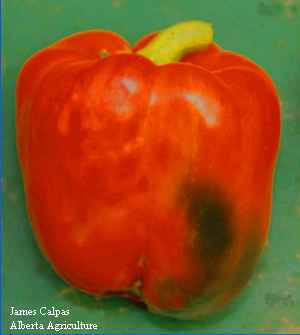
Figure 49. Pepper mild mottle virus symptoms.
Pepper mild mottle virus enters the greenhouse primarily on infected seed, transplants, plant sap and plant debris (Howard et al 1994, Portree 1996). The virus is not known to be spread by insects, but is very easily spread the routine handling of the young plants, especially at transplanting (Portree 1996). Many other plants in the Solanaceae family are susceptible, but tomato is not a host of PMMV.
Pepper mild mottle virus is related to tobacco mosaic virus (TMV) and pepper cultivars with TM resistance also have a level of resistance to PMMV (Howard et al 1994, Portree 1996).
Tobacco mosaic virus (TMV)
Tobacco is not a common disease problem in Canada although it occurs on greenhouse pepper throughout the world (Howard et al 1994, Portree 1996). The symptoms of infection first appear on the leaf as a necrosis along the main veins accompanied by wilting and leaf drop (Howard et al 1994, Portree 1996). New growth on the plants may exhibit mosaic symptoms as well as distorted growth (Howard et al 1994, Portree 1996).
Use disease-free seed and ensure that resistant cultivars are grown. Use a skim milk dip when handling the plants and remove and destroy any infected plants that develop early in the season (Howard et al 1994, Portree 1996). Mature plants can be symptomless carriers of the virus and escape detection later in the season (Portree 1996).
Tomato spotted wilt virus (TSWV)
Tomato spotted wilt virus has a wide host range, affecting approximately 300 species in 34 families of plants (Howard et al 1994). The virus is spread primarily by thrips, particularly the western flower thrips (Frankliniella occidentalis), and will only become a significant problem in greenhouse pepper crops if the thrips vector is present (Howard et al 1994).
Symptoms of infection on the leaves includes blackish-brown circular spots, or tan spots bordered by a black margin (Howard et al 1994). Symptoms on ripening fruit are quite dramatic with orange to yellow spots surrounded by a green margin, or green spots on a background of the ripe fruit color of red, yellow or orange. Not all fruit from infected plants may develop fruit symptoms, experience in Alberta pepper greenhouses has shown that only about one-third of the fruit from infected plants will develop symptoms.
Control of this virus is obtained by controlling the thrips vector. Thrips biocontrol programs should be initiated at the beginning of the season. Weeds should be kept under strict control as they can serve to harbour both the thrips vector and the virus. Maintaining a 6 meter weed-free buffer zone around the greenhouse will help prevent the introduction of thrips into the greenhouse, as well as preventing the establishment of virus infected weed plants around the greenhouse which could serve as a source of the virus. Avoid having any ornamental plants in the greenhouse as they can also serve as reservoirs for the virus.
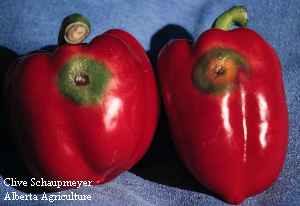
Figure 50. Tomato spotted wilt virus symptom
Tomato mosaic virus (ToMV)
Tomato mosaic virus is not a common problem in greenhouse pepper and causes symptoms very similar to those caused by tobacco mosaic virus (Howard et al 1994).
Control measures are the same as for tobacco mosaic virus. Use disease-free seed and remove and destroy infected plants (Howard et al, 1994).
Physiological Disorders
Blossom end rot
Blossom end rot (BER) is a common disorder of greenhouse peppers, with the symptoms occurring on the pepper fruit. The disorder is associated with a number of environmental stress triggers as well as calcium deficiency (Howard et al 1994). Any condition which causes water stress or a reduction in transpiration, and resultant movement of nutrients through the plants can bring on symptoms. Under watering, fluctuating water conditions, from dry to wet to dry etc., damage to the root system high E.C. in the root zone can cause BER (Howard et al 1994, Portree 1996). An actual calcium deficiency to the plant is rarely the primary cause of the disorder as BER can develop when adequate levels of calcium are being fed to the plants. The environmental factors that can trigger the disorder interfere with the movement of calcium within the plant, causing less calcium to reach the fruit. Some cultivars are more prone to this disorder than others (Portree 1996).
Symptoms of BER begin as soft spots on the fruit which develop into sunken tan-brown lesions with a very distinct
border between affected and healthy tissue. The spots usually occur on the bottom third of the fruit and are not strictly confined to the bottom, or blossom end of the fruit. Affected fruit are unmarketable.
Control is obtained by avoiding conditions of moisture stress or conditions of reduced transpiration in the crop, ensure that the plants receive adequate water and that vapor pressure deficit (VPD) targets are met. Weekly foliar applications of calcium nitrate can have a significant impact on reducing the amount of BER ( Schon 1993).
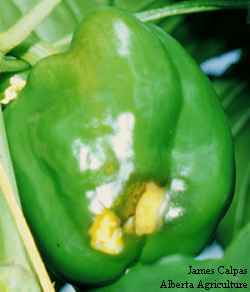
Figure 51. Blossom end rot.
Sunscald
The symptoms of sunscald on the pepper fruit are very similar to those for blossom end rot. Soft, tan coloured sunken lesions develop fruit that are exposed to direct sunlight. It is important to adjust pruning practices to ensure that all fruit are shaded from direct sunlight. Applying shading to the greenhouse during the summer months will also help reduce the incidence of sunscald. Temperatures of exposed fruit can often be 10 °C higher than shaded fruit, reaching over 35 °C during the mid day of a typical hot, sunny Alberta afternoon, even when air temperatures in the greenhouse are maintained below 27 °C. Fruit temperatures over 35 øC should be avoided (Portree 1996).
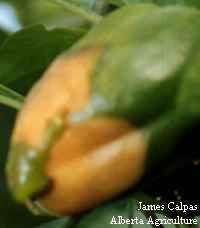
Figure 52. Sunscald.
Fruit cracks
This condition is characterized by the appearance of very fine, superficial cracks on the surface of the pepper fruit which gives a rough texture to the fruit (Portree 1996). The development of these cracks are associated with sudden changes in the growth rate of the individual fruit. The appearance of fruit cracks can follow periods of high relative humidity (over 85%), changes from hot sunny weather to cool cloudy weather or vise versa (Portree 1996).
Maintaining a consistent, optimized growing environment is the best way to prevent the development of fruit cracks.
Fruit splitting
The development of large cracks in the fruit is a direct response to high root pressure. Factors that contribute to the development of high root pressure directly impact fruit splitting (Portree 1996). Ensure that optimal VPD targets are met at all times. Adjust the timing of the last watering in the day so as not to water too late. Eliminate any night watering cycles.
Fruit spots
The appearance of small whit dots below the surface of the pepper fruit is associated with excess calcium levels in the fruit, and the subsequent formation of calcium oxalate crystals (Portree 1996). Conditions that promote high root pressure will also favor the development of fruit spots.
Misshapen fruit
The development of misshapen fruit is generally associated with sub-optimal growing conditions at flowering and pollination which result in poor flower development or poor pollination. Section 6.3.7 discusses some of the common causes of misshapen fruit, which include the temperatures being either too cool or too warm. Ensuring that all environmental targets are met and maintained will reduce or eliminate the development of misshapen fruit.
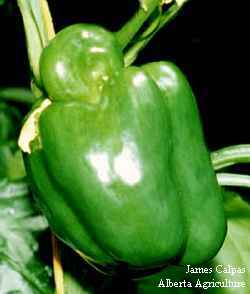
Figure 53. "Wings" on pepper fruit due to low temperatures during pollination
Internal growths in the fruit
The development of growths within the pepper usually appear early in the cropping cycle, generally on the first fruit set (Portree 1996). This results from abnormal tissue development in the honey gland of the fruit (Portree 1996). |
|